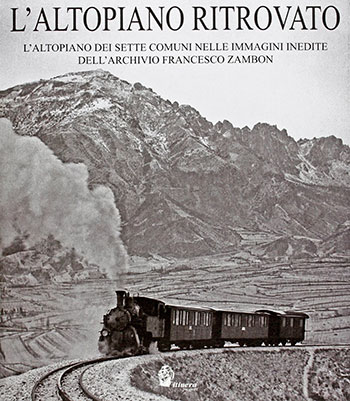
The historical memory of Paolo Pozzato, Ruggero Dal Molin, Vittorio Corà with photos by Francesco Zambon
-
Title The Rediscovered Plateau
-
Subtitle The Plateau of the Seven Municipalities in unpublished images of the Francesco Zambon archive
-
Pages 210
-
Cover Price : 35.00
-
Publishing House Itinera Projects
-
Author(s) Paolo Pozzato (Author), Ruggero Dal Molin (Author), Vittorio Corà (Author), Francesco Zambon (Photos)
-
Publish Date N/A
-
ISBN 10 8888542434
-
ISBN 13 978-8888542430
- Buy direct online
Buy Now
While today Asiago and the Plateau of theSeven Municipalities still represent an important heritage of Venetian and national tourism, in the mid-30s, resurrected from its rubble, the main center of the Vicentina mountain constituted an authentic "capital" of both summer and winter tourism.
The extraordinary flourish of activities and proposals, from real skiing, to the first games of ice hockey,from the dizzying jumps on the trampoline of Gallio to the "great bottom" of the battlefields to ensure a very high number of attendances. This tourism of the 1930s, with its features today almost evocative, against the backdrop of the often ostentatious pride of the regime relives with an extraordinary vigour in the images captured by the lens of Francesco Zambon.
❧❧❧❧
I – THE ALTOPIANO AND THE MEMORIA
ThePlateau had been fought from the first to the last day of the war, from the moment Antonio Monti in his " From thetrenches tothe rear " recalled the explosion of the first shots from the 149 mm cannons of the Verena echoing in the damp night of the Woods of Mandrielle,to when Arturo Stan-Ghellini shared – with the now ex-enemies – a few hours of sleep of the dawn of November 4, 1918 in a lurid shack of Bocchetta Portule. On the Plateau, almost all the belligerent had fought: Austrians, Hungarians, Slovenians, Bosnians, English, French, as well as members of almost every Italian region.
In a certain sense thePlateau itself almost naturally came to constitute a sacredness of painful memories, a huge silent cenotaph, guardian of the memory of events that should have been a warning to future generations. The path of Italian memory was marked, perhaps even more marked, by the evolution of history. To the pity of the comrades of the makeshift burials a short distance from the line, the great military cemeteries of the 1920s had been replaced.
They were the cemeteries recalled by Mario Rigoni-Stern in his memories of child and teenager, with the small lights that anticipated in November the cold nights of a Christmas, which no light and no fire would still revive. These are the same constructions desired by human piety that C.D. Bonomo had immortalized with the lens of his camera in the volume, Visions of Gloria,published in 1924 and which Claudio Rigon and Mauro Passarin have revisited with extraordinary suggestion in more recent years. By the middle of the next decade, the shrinehad arrived. The quadruple arc of triumph set on the macaw of the sacrifice, in turn erected above the chapel of the gold medals, all placed at the top of the hill of Leiten became the elements of what Mario Isnenghi rightly called a "narrative sequence", destined to impose itself strongly in the imagination of the most distracted of visitors, at least of that period.
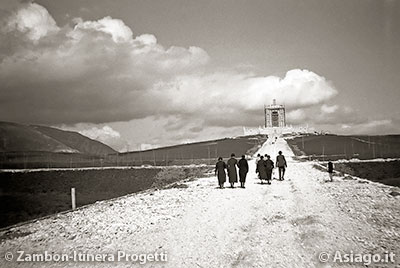 The images fixed on the film by Zambon seem to punctuate presences, messages, even absences. The shrine packed with troops,the dutiful and obvious tribute to the authorities, religious symbols and regime insignia thus find the counterpoint of solitude, or rather solitude. The attention of the photographer seems more attracted by the melancholy: that of an isolated car at a log pile, cut at last to build and not to destroy, or even more that of the isolated passer-by, who does not even look at the cemetery that skirts, for an excess of modesty, certainly not for the neglected distraction of today.
The images fixed on the film by Zambon seem to punctuate presences, messages, even absences. The shrine packed with troops,the dutiful and obvious tribute to the authorities, religious symbols and regime insignia thus find the counterpoint of solitude, or rather solitude. The attention of the photographer seems more attracted by the melancholy: that of an isolated car at a log pile, cut at last to build and not to destroy, or even more that of the isolated passer-by, who does not even look at the cemetery that skirts, for an excess of modesty, certainly not for the neglected distraction of today.
❧❧❧❧
II – THE GREAT AND THE BIG WEEK
Onehundred years after the outbreak of the First World War, one cannot ignore the fact that returning to the places where so many young lives, Italian and Austro-Hungarian, had been sacrificed is one of the few sure ways to preserve their memory, to "not forget", the entity and the sense of a sacrifice. The only real insult to those who died then is to spend today on the same places with the distraction of the tourist who has nothing to learn, who even ignores the size of his superficiality. If today we wanted to turn theOrtigara,the Zebio,the Cengio into open-air museums is certainly not to chase the logic of an "amusement park of history", much less to distance the visitor from the "pietas" that led in the decades of the first post-war to realize a few, significant monuments.
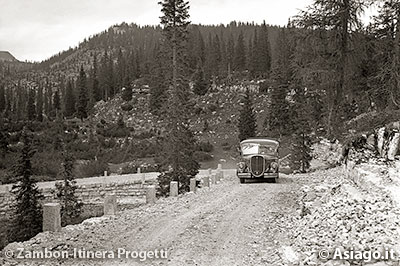 Rather, it has been reiterated that an authentic memory is never self-paying, that it is not satisfied with the chimeras of the plausible and the convincing, but chases, tenacious and inexhaustible, the difficult and not infrequently disappointing tracks of truth. Along those same tracks they seem to bring us even the snapshots of the author. There is in fact nothing "set", nothing rhetorical in the gatherings of friends who stop at a farmhouse, consume the packed food inside the ruins of the Lisser Fort,which gather in front of Cima Twelve; nothing of fended by this carefreeness; there is no disrespect for the fringes that made the same places the scene of death and suffering. Not surprisingly, perhaps the following summer, if not the previous one, the same goal sets the memory of the hiker bending over the ortigara's severed column while giving a dutiful greeting to the fallen.
Rather, it has been reiterated that an authentic memory is never self-paying, that it is not satisfied with the chimeras of the plausible and the convincing, but chases, tenacious and inexhaustible, the difficult and not infrequently disappointing tracks of truth. Along those same tracks they seem to bring us even the snapshots of the author. There is in fact nothing "set", nothing rhetorical in the gatherings of friends who stop at a farmhouse, consume the packed food inside the ruins of the Lisser Fort,which gather in front of Cima Twelve; nothing of fended by this carefreeness; there is no disrespect for the fringes that made the same places the scene of death and suffering. Not surprisingly, perhaps the following summer, if not the previous one, the same goal sets the memory of the hiker bending over the ortigara's severed column while giving a dutiful greeting to the fallen.
❧❧❧❧
III – THE ALTOPIANO AND THE SPORTS INVERNALI
Wehave seen how it is essential for Francesco Zambon to return the mountain to the general public, as in the influx of tourists to Asiago he sees anything but an undue invasion of other people's spaces and dimensions. The images, which are not exaggerated to define poetics, of the train advancing in the snow or those, undoubtedly more prosaic but certainly no less significant, of the row of torpedoes in front of the Leiten are indicative of a look that captures all the technical difficulties that must be overcome, but at the same time knows how to note all the opportunities that they enclose, for users as well as for the inhabitants. Asiago is in his eyes, and must become with increasing awareness, the capital of the Venetian winter. For Zambon, winter snow is the field of action for thehiker, keeper and mentor ofthe battlefields, but it is at the same time the ground for cross-country and downhill competitions, trampoline jumps and biathlon challenges,sports competitions and hockey games.
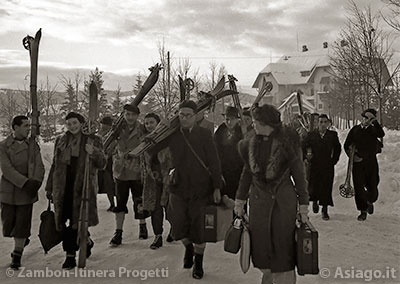 Of course he did not imagine that in the 21st century the Asian team would claim the second consecutive Scudetto, the third in its history, but it undoubtedly believed in the attractiveness of a sport that not many would bet on then. Snow is also the field for a new relationship between the sexes. The shots of women skiers,rather than those engaged in archery,go far beyond the setting of the 1930s and rather foreshadow the reality of today, with awomen's sport That now has nothing to envy to the male counterpart, when it does not exceed it greatly in the results. On everything dominates – once again – the weight of concreteness, the sense of immediate feasibility, of the opportunity to be seized immediately and not in a hypothetical future.
Of course he did not imagine that in the 21st century the Asian team would claim the second consecutive Scudetto, the third in its history, but it undoubtedly believed in the attractiveness of a sport that not many would bet on then. Snow is also the field for a new relationship between the sexes. The shots of women skiers,rather than those engaged in archery,go far beyond the setting of the 1930s and rather foreshadow the reality of today, with awomen's sport That now has nothing to envy to the male counterpart, when it does not exceed it greatly in the results. On everything dominates – once again – the weight of concreteness, the sense of immediate feasibility, of the opportunity to be seized immediately and not in a hypothetical future.
❧❧❧❧
IV – THE ATOLROMEO SARTORS OF ASIAGO
it is natural that the head of theVicenza airport included in his vision of tourism in the Plateau also the airport. Especially since in Asiago the regime had wanted to establish in 1936 the First School of Flight Sailed in Italy and in Asiago and the Plateau in 1940 Giogio Ferroni will dedicate one of his films: "The Intoxication of Heaven", which will be screened in all the cinemas of Italy. Thus in the second half of the 1930s, thanks to the fundamental contribution of the R.U.N.A., the equivalent of the current Aeroclub d'Italia, Zambon could bring together on the old runway of the First World War some of the touring aircraft – but not without interest also for the Military Aviation – produced by the national industry. In the series of snapshots taken in front of the hangars or in the stunts carried out against the backdrop of theInterrupted and the Bi are in fact recognized the Fiat G 8 CHASA,whose prototype had flown in 1934,and the Breda Ba 39 that had risen in the air for the first time in September 1932.
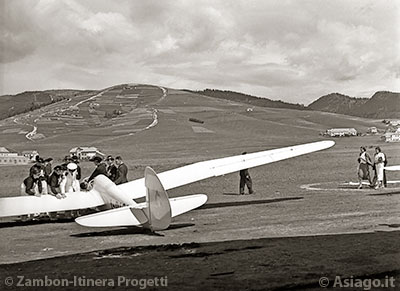 There is also, and would have been difficult, the claim of the new role of the woman,no more simple dreamy spectator of the feats of the air riders, but splendid mechanic-driver in white suit, posing in front of the engine of his Fiat.
There is also, and would have been difficult, the claim of the new role of the woman,no more simple dreamy spectator of the feats of the air riders, but splendid mechanic-driver in white suit, posing in front of the engine of his Fiat.
Nevertheless, a sense of melancholy is narrowly escaped, looking at them, especially if we pass today alongside an airport too often desolately empty, an airport and a runway that seem justified only by the greenery that surrounds them and which still seem well determined to defend against everything and against everyone.
❧❧❧❧
V – THE ASIAGO TRAIN - ROCCHETTE
The small rack ingess of the Rocchette -Asiago railway, which opened in February 1910,was then hailed as a decisive factor for the economic and tourist development of Asiago and the Plateau,have irretrievably disappeared. That ferrata line that during the First World War had supplied the troops of the Plateau and that the command of the 1st Army had planned to extend to the Ghertele,has now become the itinerary reserved for the walks of less adventurous tourists or excursions of bikers. To those who still daydream about seeing the saucy puff of the vapour reappear beyond the woods of Campiello,to those who regret the preference given at the time to couriers, to those who finally think – more prosaically – what attraction would today represent even just a weekly climb on the old rack just have to rely on the snapshots of Zambon.
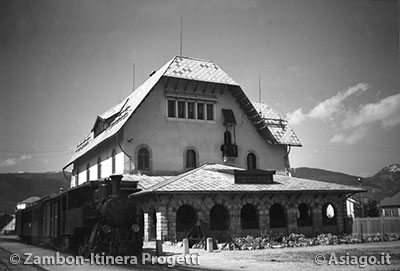 In them it does not only relive a means of transport, despite all its de-modé charm,it relives a whole world, a world disappeared and unrepeatable. it is a world in which even the journey, far from enclosing the stress of waiting or boredom, was an integral part of that Sunday dedicated to the Plateau and its snow. As during his excursions on the Portule or theOrtigara,the passage of man and his means – little matters the skis or the coarsal wheel – often remain only the traces. In the puff of triumph of the locomotive finally arrived at the Asiago station,after so much trudging, it seems to resent the blowers of Alba and Franco in the unrepeatable magic of Mario Rigoni Stern's"urogalli forest". You just have to close your eyes and rely on the temptation of the "Once Upon a Time...".
In them it does not only relive a means of transport, despite all its de-modé charm,it relives a whole world, a world disappeared and unrepeatable. it is a world in which even the journey, far from enclosing the stress of waiting or boredom, was an integral part of that Sunday dedicated to the Plateau and its snow. As during his excursions on the Portule or theOrtigara,the passage of man and his means – little matters the skis or the coarsal wheel – often remain only the traces. In the puff of triumph of the locomotive finally arrived at the Asiago station,after so much trudging, it seems to resent the blowers of Alba and Franco in the unrepeatable magic of Mario Rigoni Stern's"urogalli forest". You just have to close your eyes and rely on the temptation of the "Once Upon a Time...".
❧❧❧❧
VI – THE AUTHOR OF THE PHOTO FRANCESCO ZAMBON
OnAugust 16, 1901,at Thiene, just a year later than the last class called to arms during the First World War, Zambon seems predestined already in the day and month of birth to dedicate his life to "holidays", especially those of others. The young Zambon,who in 1927 moved to the Vicenza Chamber of Commerce,to become three years later director of the provincial tourist office, has no vocation for the quiet life of the travet. Also because he senses that it is precisely the almost naturally tourist vocation of Vicenza and its province, in particular of its mountainous area, that can play a decisive role in the revival of one of the regions that have taken the most for eavescapable participation in the conflict. Equipped with an extraordinary organizational capacity,which will make use ten years later as an officer in charge of the military commissioner of the C.S.I.R.,the primitive nucleus of our forces operating in Russia,journalist and photographer of absolute thickness, maker among the first of film documentaries often awarded to international film exhibitions, Zambon puts these skills at the service of his province.
It is certainly from the early 1930s the photos of torpedoes that trudge on the road leading to Piazzale Lozze,of the central phase of the decade the series of images that follow the birth of the Sacrario,on the hill of Leiten,until the day and the imposing ceremony of its inauguration. it is, however, at the end of the 1930s, when Asiago and the Plateau are reborn from their own ruins, that they become for the lens of his camera, as for those who today review his shots, the undisputed capitals of Vicentino tourism. It may even seem incredible, leafing through today's snapshots of Zambon,that on the meadows north of the city of Asiago it was possible to collect so many planes and many pilots, not excluding some gorgeous female figure in immaculate white flight suit.
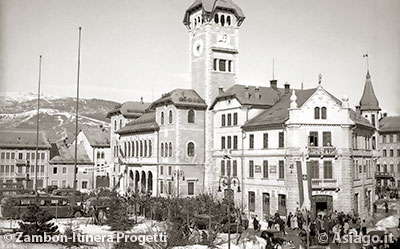 With the outbreak of World War II, allied air raids on Vicenza saw him taking away bombs, Turkish scenes and Olympic statues, Tiepolo frescoes at Villa Valmarana and the stained glass windows of the Temple of Santa Corona. The post-war events, however, will take him a long way. In 1952,in fact, the thienese who had erected Vicenza to his residence and Venice to his ideal city becomes in fact president of the tourist promotion agency of Siena. He will return to Veneto in 1958, as director of the padua tourism body. Finally, retiring from public life, he will continue to devote himself to the enhancement of the territory of vicentino without ever receiving, in truth, a true recognition for the work done.
With the outbreak of World War II, allied air raids on Vicenza saw him taking away bombs, Turkish scenes and Olympic statues, Tiepolo frescoes at Villa Valmarana and the stained glass windows of the Temple of Santa Corona. The post-war events, however, will take him a long way. In 1952,in fact, the thienese who had erected Vicenza to his residence and Venice to his ideal city becomes in fact president of the tourist promotion agency of Siena. He will return to Veneto in 1958, as director of the padua tourism body. Finally, retiring from public life, he will continue to devote himself to the enhancement of the territory of vicentino without ever receiving, in truth, a true recognition for the work done.
❧❧❧❧
This book therefore aims to be not only a story, guided by the evocative force of the images, of the Plateau of the Seven Municipalities in the 1930s and 1940s, but also a dutiful tribute to a man who has devoted much of his life to the development, not only tourism, of the Venetian mountain for which, perhaps, only Gianni Pieropan, in more recent years, has done the same for the enhancement of its history and the events of war.
All rights reserved.